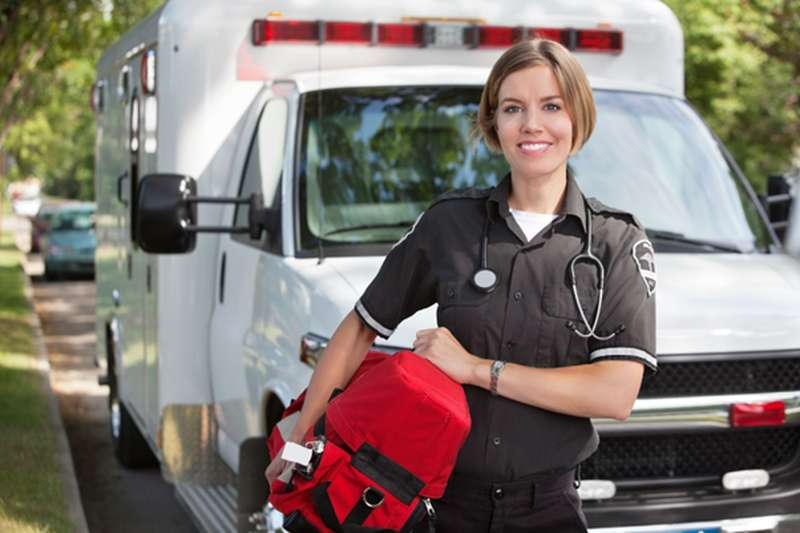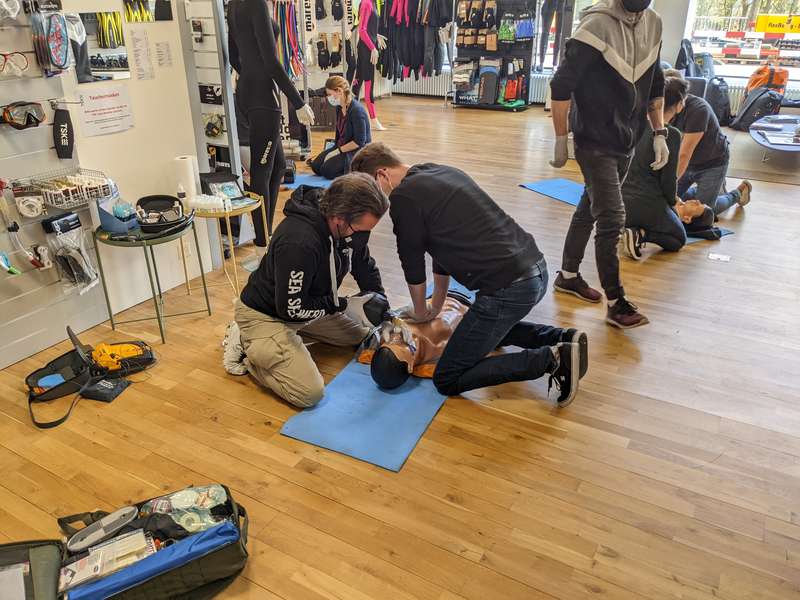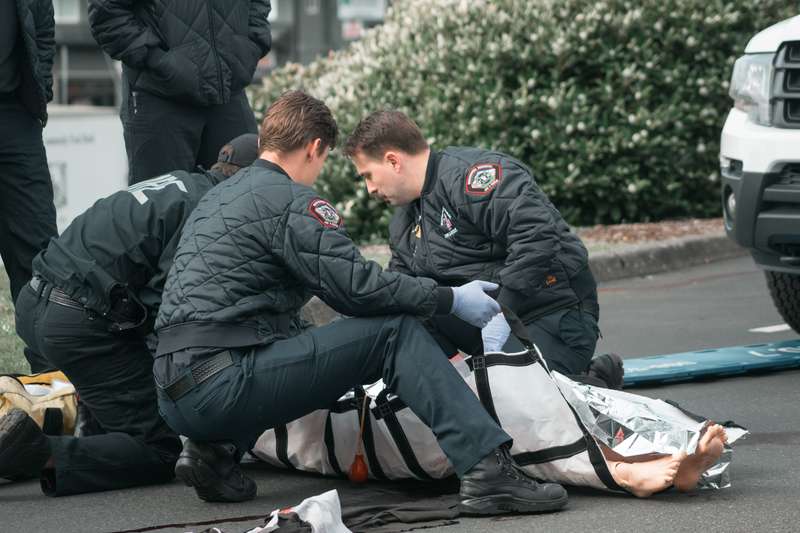An emergency medical technician, or EMT, is a first-responder medical professional. They provide immediate care at the site of the emergency to stabilize a patient and their most immediate injuries, and then the EMT safely transports the patient to a hospital.

Working as an EMT requires more than just a basic understanding of first-aid. They are well-trained health care providers who can think quickly and analytically in a high stress situation. To better understand the role of an EMT and how to become one, keep reading.
The Role Of An EMT: Job Responsibilities
The foundational role of an EMT is to keep their critically ill or seriously injured patients alive. They perform life-saving procedures on the site of the emergency and in an ambulance while in transport to make up the difference between life and death for a patient.
EMTs are often called to situations where they treat patients with injuries such as gunshot wounds, stab wounds, or other critical injuries received in an accident, such as a car crash. If someone dials 911, EMTs are the fleet of responders that are sent out to heed the call.
Common Responsibilities of an EMT:
Performing first-aid as needed
Responding to emergency calls
Assessing a patient’s condition and quickly choosing the best way to treat them
Stabilizing the most urgent injuries first
Determining the best place to take a patient, such as an ER or Instacare
Communicating with other emergency responders, such as police officers and firefighters
Comforting patients who are afraid, in pain, and in distress
Recording the medical care they administered to a patient
Reporting their medical observations and treatments to physicians and nurses in hospitals
Sanitizing and restocking used medical supplies
Working 12 hour or 24 hour shifts and on call hours
Common Procedures EMTs Perform:
Providing life-support interventions, such as CPR
Controlling bleeding and dressing wounds
Treating minor wounds
Opening and maintaining patient airways
Performing physical exams
Assisting in childbirth
Administering oxygen when necessary
Administering medications (some states allow EMTs to do this)
Treating symptoms of shock
Professional Skills EMTs Use Every Day
Because an EMT often works in a high-stress environment, they need certain skills that aid them in performing their responsibilities effectively. Individuals who work as EMTs generally thrive in fast-paced, quick-decision making scenarios.
Most successful EMTs have these skills:
Critical thinking
Problem solving
Fast decision making
Effective communication
Composure under pressure
Situational awareness
Patience
Mental resilience
Physical stamina
Stress management
Compassion
Empathy
Good listening
Steps To Become An EMT
To become certified as an EMT, you must meet certain requirements, take an EMT training program, pass the NREMT exam, and apply for licensure. Upon completion of these steps, you can be hired to work as an emergency medical technician.
1. Receive a High School Diploma or GED
Before you can apply for any type of EMT training, you must have a high school diploma or GED and be at least 18 years old. An associates or bachelors degree is not required.
2. Gain CPR Certification
Your next step is to acquire your CPR certification. The American Red Cross and other local organizations offer such classes. A CPR training course will only take about 2-3 hours. These certifications last for 2 years, so make sure yours is still valid before applying for step 3.

3. Take an EMT Training Program
EMTs must take an EMT training program to become a certified and licensed EMT. These courses generally take 1 to 2 years to complete, and they include both in-class instruction and in-the-field experience. They’re offered at technical schools and community colleges.
These courses are designed for people who already have day jobs, so it is possible to take the courses in the evenings, on weekends, or sometimes online. Make sure it is an accredited, state-approved EMT course. They may also be offered at fire stations and by the Red Cross.
Your areas of study will include:
Airway management
Head and trauma injuries
Medical and ethical issues in healthcare
Cardiopulmonary resuscitation (CPR)
Properly lifting and moving a patient
How to treat children and infants
Splinting broken bones
Pharmacological interventions
General emergency medical service operations
Wound management
This is not a comprehensive list.
As part of your training, you will be expected to ride along in an ambulance and observe EMTs at work for a specified allotment of hours. Some employers may even expect you to have a minimum of 6 months clinical experience before they will hire you.
4. Pass 2 Exams to Become Certified and Licensed
After taking your EMT program, you will need to take and pass the National Registry Emergency Medical Technician (NREMT) exam. There are two parts to this: the cognitive exam and the psychomotor exam.
The cognitive exam will assess your knowledge of respiration, gynecology, cardiology, trauma response, and other topics. It is computerized with 60 - 110 questions, and you can take it up to 6 times before needing to retake an EMT course.
You will coordinate your psychomotor exam with your state EMS office or educational institution. This is a practical exam where you demonstrate your skills in simulated scenarios with pretend patients. You can take this exam 2 times before needing to retake your EMT course.
After passing both exams, you will become a licensed EMT.
Different Types Of EMTs
There are varying levels of emergency medical technicians, and they include Basic EMT and Intermediate EMT. Their categorization is due to the amount of training they have received.
Basic EMT
Basic EMTs have completed the 110 -150 hours of coursework and passed their NREMT exams. They are entry-level healthcare providers who offer non-invasive medical treatment–meaning they cannot do anything that includes breaking someone’s skin.
Intermediate EMT
Intermediate EMTS have completed 200 - 400 hours of coursework and passed their NREMT exams. They can administer more complicated procedures such as inserting IVs, using airway devices, reading EKGs, administering some medications, and providing invasive care.

Some states would call these “advanced EMTs,” but other states reserve that title for paramedics who have gone on to complete even more coursework and training.
Conclusion
EMTs are essential healthcare professionals who provide much needed service for patients in urgent and emergency situations. They have dedicated much effort and time to learning how to treat patients in critical condition, and our society is grateful for them.
References
“EMT Emergency Medical Technician Job Description [Updated for 2022].” Www.indeed.com, 10 Dec. 2022, www.indeed.com/hire/job-description/emt-emergency-medical-technician.
“What Are the Job Duties of an Emergency Medical Technician (EMT)?” Learn.org, 2018, learn.org/articles/What_are_the_Job_Duties_of_an_Emergency_Medical_Technician_EMT.html.
“What Does an Emergency Medical Technician (EMT) Do? Duties, Salary, and More.” Coursera, 21 Dec. 2022, www.coursera.org/articles/emergency-medical-technician.
“What Is an Emergency Medical Technician (EMT)?” Indeed Career Guide, 28 Nov. 2022, www.indeed.com/career-advice/career-development/what-is-an-emt#:~:text=Common%20duties%20of%20an%20EMT%20include%3A%201%20Respond.


